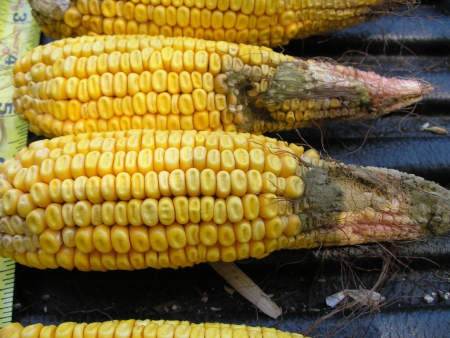 Aflatoxins are the toxic metabolities of toxigenic fungi Aspergillus flavus and A. parasiticus. These moulds invade and
grow on all sorts of stored feed ingredients and organic matters and produce
mycotoxins under favourable aerobic conditions when sufficient moisture
(>15%) and relative humidity (90-95%) and ambient temperature (24-25oC) are
available, through toxin production to some extent can take place at lower or
higher temperatures as well.
Aflatoxins are the toxic metabolities of toxigenic fungi Aspergillus flavus and A. parasiticus. These moulds invade and
grow on all sorts of stored feed ingredients and organic matters and produce
mycotoxins under favourable aerobic conditions when sufficient moisture
(>15%) and relative humidity (90-95%) and ambient temperature (24-25oC) are
available, through toxin production to some extent can take place at lower or
higher temperatures as well.
Aflatoxins are produced in varying quantities in a
variety of grains and nuts, pea nut is the most important one. Cotton see meal,
cotton seed cake, maize corns, com-meals, silages, wheat, barley, oats, rice and other grains or cereal products
are invaded by these fungal
toxins.
Several aflatoxin
fractions have been isolated and differentiated from one another by their
fluorescence under ultraviolet, RF values on thin layer chromatography and structural
identification and synthesis. Aflatoxins which fluoresce blue under ultraviolet
light are termed as BI and B2 while others
which are dihydroderivatives of B1 and B2 and
fluoresce green are designated as G1 and G2 Hydroxylated metabolites of B,
and B2 aflatoxins are excreted in milk
and are termed as MI and M2. Human exposure occurs on consumption of
aflatoxins from the mycotoxins- infested feed stuffs as well as meat and milk
of animals consuming toxigenic fungi contaminated feeds.
Out of the four main
aflatoxins, aflatoxin B1 (AFB1) is most important because of its toxicity
and high concentration in the contaminated feeds. B2 and G2 are present in very less concentrations. The order of toxicity is: B1 > G1 > B2 > G2. These toxins are relatively heat resistant
and not soluble in water. The melting
points for BI, B2 ' GI
and G2 aflatoxins
are 269°, 238°, 245° and 239°C, respectively. Even the toxigenic fungi or toxins are not
destroyed by milling of the grains.
Aflatoxins are a group of
polycyclic, unsaturated, substituted coumarin derivatives with
highly reactive bifuran nucleus on one side and a pentenone (B toxin) or a six
membered lactone (G - toxin) ring on the other side as shown in Fig. 8.1.
Presence of additional oxygen in the AFG compounds results in reduction of their activity by a
factor of 2 while unsaturated compounds are 4-5 times more potent compared to
dihydro derivatives. The structure of B
toxin resembles closely with the structure of pyrrozolidone which has got basic
carcinogenic activity. Aflatoxins are potent mutagens, carcinogens, teratogens and liver damaging agents.
Mechanism of toxicity: Majority of the aflatoxins
ingested in feed are physically bound to ruminal contents and as little as 2-5% reach the intestines. Aflatoxin BI in excess of 100 mg/kg of feed is considered to be toxic to cattle. Aflatoxins are rapidly absorbed from the
intestine and bound to blood proteins. Liver removes most of the toxins from the
blood stream. AFB1
is primarily metabolized by a microsomal cytochrome P-450 dependent mixed function oxidase system
in the liver and other organs to AFB1 -2,3 epoxide mainly, which is
a highly reactive intermediate. Other metabolites of AFB1 are Q1, P1, B2 and aflatoxicol. Epoxides are chiefly detoxified by
glutathione

No comments:
Post a Comment